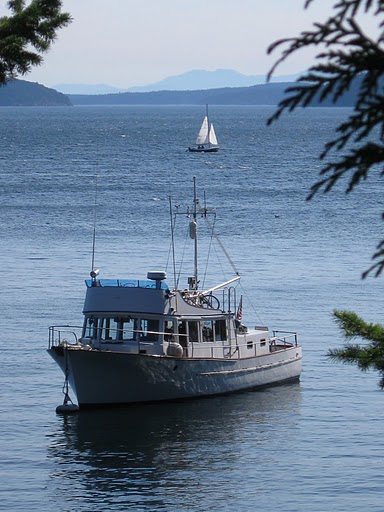http://mvvikingstar.blogspot.com/2012/01/refinements-to-water-maker.html
Like all shade-tree ideas it is based on some sound reasoning: RO membranes output is very temperature dependent. And the warmer the input water, the more one can expect to get out of them. So, last summer I re-routed things like this:
 |
| Good concept, bad idea. Keep reading! |
Note how the water flows through the Kubtoa engine 1st, THEN on to the watermaker! Ha, Free Heat, Wow - really putting out the fresh water now.. This winter I am thinking about doing some more plumbing to the poor little Kubota, working to see if I can better manage its cooling and gets its operating temperate up (currently it runs around 160f or so, a bit too cool I think). After thinking of several approaches the one I have settled on trying is a variable bypass of sea water around the heat exchanger. Have located a sea-water safe 12v valve and will control it via the Arduino controller.
While I was at it I started wondering: Just how much temp raise am I getting into the water maker using the above? Trying to measure it using an external IR thermometer did not give me too much of a raise. And after all there are a few downsides to the engine-1st approach:
- Increased hoses and complexity. Starting to look like an early 80's GM car engine with all its hoses and such.
- Health concern in case of faulre of engine heat exchanger, mixing coolant in with sea-water (I am not sure what the RO membranes would do and have been using low-tox antifreeze just in case)
- Interjection of Zinc into stream of water passed on to the RO membranes, again not sure what all that does..
- Lost fresh-water flush of engine when flushing out RO membranes after each run.
This last one kind of bummed me, as with the old plumbing every time I fresh-water flushed the RO system, the outflow would be passed down and fresh-water flush the engine as well.
So, Just for Fun I did some math this afternoon:
- A BTU is defined as the amount of energy needed to raise 1lb of water 1f
- A gallon of Diesel has 138,500 BTUs
- The Kubota burns about .25 - .3 GPH of fuel
- Seawater Pump pumps about 4GPM (per spec)
- Rule of thumb says 25% of fuel burnt goes into the coolant (another 25% into work, and 50% out the exhaust).
So, lets do some math!
138,500 BTU/Gal * .3 GPH * .25(25% of heat into the coolant) = 10,387 BTUs/hr of heat into the sea-water.
10,387 BTU/hr = 10,387 Lbs*F/hr (1 BTU warms 1lb of water 1f)
4 GPM * 60 Min/Hr * 8.33 lb/gal = 1999lbs/hr of sea water moved through the engine.
(Sea water is actually heaver then this, but as this is the "back of the Blog" doodle, lets just use 8.33lbs/gal)
(And hey: Math guys, dbl check I did this right. I even worked to carry forward the Units; my Physics teacher would be so proud!)
================================================
4/8/2015: Well, a Math Guy did dbl check my figures, and gave me an 'F' (See comment below from Bruce). Forest from Trees, did not do a simple 'sniff test' on that last formula - and the 'units' did not help me any as they were the same (and hence canceled). So, Bruce, here we are - showing my work:
Combining them: 10,387 BTU/hr = 1,999lbs/hr * Xf
or: 10,387 lb*f/hr = 1,99lbs/hr * Xf
Solving for X --> (10,387lb*f/hr) / (1,999lbs/hr) = Xf
the lb/hr cancel (See, units to the rescue!) leaving us with:
10,387f / 1,999 = Xf
Xf = 5.19f And even the units match!
So, bottom line: I should expect a 5 degree F raise in the feed-water temperature into the RO membranes.. Using this table from Dow:
Temperature vs Rated Fresh Water Production
| |||
Degs F
|
Degs C
|
% of Rated Production
| |
40
|
4
|
38
| |
50
|
10
|
58
| |
60
|
15
|
72
| |
70
|
21
|
88
| |
77
|
25
|
100
| |
80
|
28
|
109
| |
90
|
32
|
127
| |
100
|
38
|
147
| |
and starting with 50f water (perhaps a little warm here in the PNW), that 5 degree rise might get me an extra 7% output. Perhaps worth it. As of 2015 I had replumbed to remove this pre-heating. I think I will take some actrual inlet / outlet measurments from the engine heat exchanger and see how those compair to the calculations - then deside what to do...
Thanks again Bruce, and like your You-tube clip of your rig:
https://www.youtube.com/watch?v=HjgvyppxR0g

No comments:
Post a Comment
Note: Only a member of this blog may post a comment.